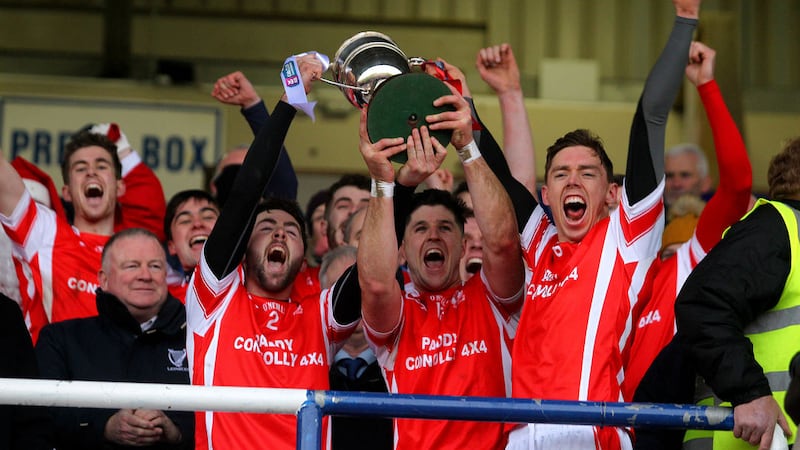IN 2008, former Dublin defender Paul Curran promoted the idea that the county should abandon ineffective development squads and go down the line of giving more and more competitive football to clubs.
The reason they are where they are now is because they sorted their underage problems out, but not quite in the manner he suggested.
Three months ago, he wrote of their adrift competitors: “For most they should forget about spending big money on management teams and the vast amounts needed to just play a couple of games in the summer and put the resources into a 10-15 year underage programme employing good coaches and looking after their young players.”
Learning lessons from professional sports and moulding them to our own needs has been one of the great successes of the GAA in recent years.
Ever since the Class of ’99 came hurtling down the track at Old Trafford, the academy system has exploded in Premier League soccer.
The general theme since has been to plough more and more money into the academy system. Last year, Manchester City led the way, spending £12m on theirs. But what does it produce?
Of the 1.5million youth footballers playing on any given weekend in England, only 180 will ever play a single minute of Premier League football – a staggeringly low 0.012 per cent.
Earlier this year, Huddersfield Town took the rather unprecedented step of effectively shutting down the engines on their academy.
No wonder. It cost £1m a year to run and since 1999, had produced just one Premier League player in Jon Stead, who didn’t break much delph.
It had simply become an ineffective method of producing the kind of quality player they needed.
The GAA has gone down the academy route in recent years. Every county either has or is striving to produce top-class facilities and coaching with which to develop young players.
But many of Dublin’s clubs are so well resourced that they are, in effect, full-time academies.
For example, take the weekend’s two hurling finalists, Kilmacud Crokes and Cuala.
The Crokes have two full-time coaches, one of them Páraic McDonald, a Monaghan man.
Meanwhile in Dalkey, they have a “coaching department” that delivers its own workshops to Cuala coaches, running over 40 of them in 2016 alone.
This is where the roots of the disconnect between Dublin and the rest begin.
The clubs are taking on a large chunk of the cost and taking some of the rewards through their own senior teams, while the Dublin county teams get to call upon the crème de la crème.
It is the perfect model.
The problem for other counties is that they haven’t enough cloth to cover the whole table, and there’s only so much patching in you can do that people won’t pick at the holes.
And yet you would question whether academy squads, or development squads as they were called until recently, are truly effective for the majority. And that depends how you view success.
There is little debating that the quality of facility and coaching available to young players in such squads is almost always superior, particularly those from traditionally weaker clubs.
Crucially, they have access to a higher class of strength and conditioning work, which in the modern game is invaluable.
But you can follow the train of thought quite easily: We don’t have the money to put full-time coaches into every club. There aren’t enough cash-rich businesses about for the clubs to finance themselves. There are only 15 senior county jerseys and if we bring enough through our academy system, we might be able to compete.
Pragmatism is behind a lot of it, but Dublin have planted the seed: Is the current model, which is followed by almost all counties, the most effective way of producing a line of top-quality footballers?
Your average county maybe spends somewhere between £1m and £1.5m per year. Some boards do a good job, some don’t.
A massive chunk of that usually goes on the senior team alone.
But say you’re Laois. Not to disparage their current crop but they won’t win Leinster in either code any time soon. Yet, as a county, they spent almost €700,000 on their senior teams in 2016.
Nobody can tell me that’s the best use of resources. Would a big chunk of that money not be better invested in hiring more full-time coaches, and redistribute their time so that they’re coaching other coaches as often as they’re coaching players?
Then there’s the clubs themselves. Many are handing their senior managers a fee that would come very close to paying a full-time coach. The money is floating around but too many people are doing the wrong things with it.
Ultimately the pathway to a broader success for any county is to have a wider scope of quality coaching, but all this money is being pumped into the small number of players availing of the elite squads.
Imagine you took two smart men from every club, invested in them and armed them with the tools with which to improve standards in their own little hole in the hedge.
There is a deeper financial consideration to be had, of course, than this back-of-a-postage-stamp plan of mine. It is a costly venture to put men into full-time employment.
But the idea that the vast majority of counties are investing so heavily in such a small number of players seems back-to-front. It’s a huge financial investment for so little return.








